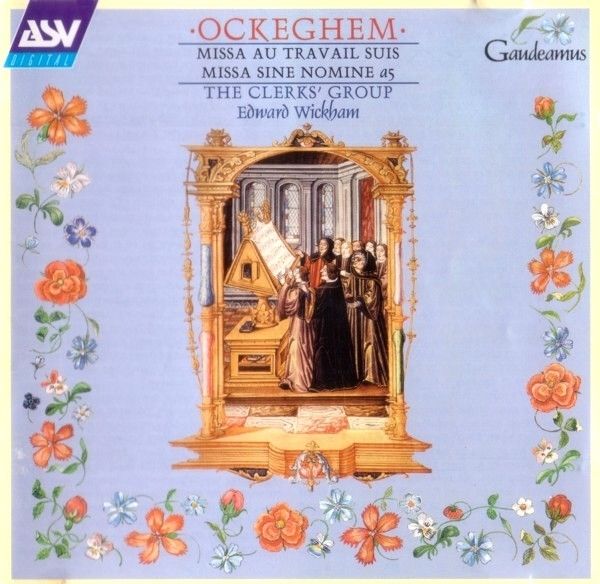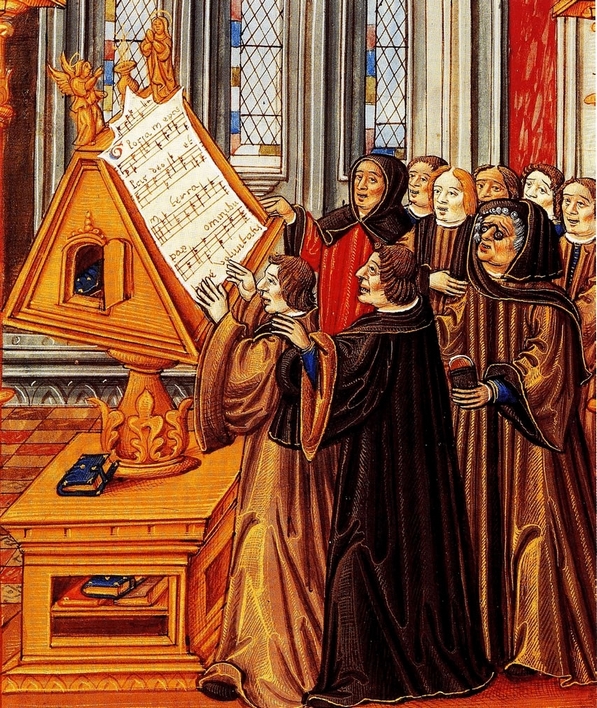Johannes OCKEGHEM. Missa Au travail suis · Missa Sine nomine a 5 / The Clerks' Group
Mort tu as navré · Petite camusette · (attr.) Permanente vierge · Intemerata Dei mater
BARBINGANT (attr.). Au travail suis

medieval.org
AS&V "Gaudeamus" CD GAU 215
2000
BARBINGANT
(fl. 1445-1455)
1. Au travail suis [4:33]
soprano, 2 tenors
Johannes OCKEGHEM
(c. 1410-1497)
Missa Au travail suis
altos, basses JA FB ED
2. Kyrie [1:37]
3. Gloria [4:09]
4. Credo [5:23]
5. Sanctus and Benedictus [3:41]
6. Agnus Dei [4:11]
7. Mort tu as
navré [7:59]
alto LB, tenor TR, basses RM EW
8. S'elle m'amera ~ Petite camusette [3:52]
alto WM, tenors, bass JA
9. Permanente
vierge ~ Pulchra es ~ Sancta Dei genetrix [6:20]
(attr. OCKEGHEM)
alto RB, tenors, basses JA EW
Missa Sine nomine a 5
altos RB WM, tenors, basses JA RM
10. Kyrie [0:56]
11. Gloria [2:28]
12. Credo [3:41]
13. Intemerata Dei
mater [5:54]
alto WM, tenor MV, basses JA RM EW JFA
THE CLERKS' GROUP
Soprano: Carys Lane
Alto: Lucy Ballard, Robin Blaze, William Missin, Kim Porter
Tenor: Tom Raskin, Matthew Vine
Bass: Jonathan Arnold, Francis Brett, Eamonn Dougan,
Jonathan
Freeman-Attwood, Robert Macdonald, Edward Wickham
Produced by Jonathan Freeman-Attwood
Recorded byDavid Wright / Gemini Sound
Recorded in St Andrew's Church, West Wratting, 22-24 February 1999
Designed by Studio B, The Creative People
Cover: Illustration from "Chants Royaux sur la Conception Couronee du
Puy de Rouan" 1519-1528 Ms Add 1537 fo 58
"Motet exquis chef d'oeuvre
de nature".
The choir sings the Gloria, conducted by Jean Ockeghem,
courtesy of Biblioteque Nationale, Paris, France/Bridgeman Art Library

All the works on this recording, the last of The Clerks' Group's
traversal of Ockeghem's complete sacred music, are thought to stem from
the composer's maturity. As such, they must have been composed for the
singers of the French royal chapel, which Ockeghem led for most of his
working life.
The Masses Au travail suis and Sine nomine a5 are his
shortest Mass settings, rivalled only by Cuiusvis toni (on CD
GAU 189). Au travail suis is unique on account of its scoring
for two high and two low voices roughly an octave apart. For most of
the Mass Ockeghem divides them into different combinations of pairs
pitted against each other. The starkness of these dialogues is smoothed
by the equally melodic character of all four voices. The resulting
interplay of textures, heard most clearly perhaps in the Credo, is
typical of the composer. Unusual, too, is the Mass's relationship to
its model, the eponymous song ascribed in one source to Barbingant, in
another to Ockeghem himself. The song's tenor appears in full only in
the Kyrie (where it is the last of the four voices to enter);
thereafter, it is clearly heard only at the beginning of each movement,
and again at the end of most sections, where it is heavily disguised.
In between, the composer's fantasy has full rein: who can think of a
more striking conclusion to a Mass movement than those of the Gloria or
the Credo, or the arresting statements of "Hosanna in excelsis"?
Au travail suis is one of the composer's most individual
creations.
The even shorter five-voice Mass Sine nomine is a ferial
setting: that is, it was designed to be sung on non-feast days when the
court might wish to hear polyphony, and yet not prolong the service of
the Mass unduly. The desire for brevity is evident throughout: the
Kyrie lasts less than twelve bars. All three movements are based on
plainchant settings; in the Credo, the Tenor voice (in the middle of
the texture) can be heard reciting the very long text complete, but in
very short notes, as though in imitation of a priest intoning
plainchant at top speed. (Busy rulers were known to favour prelates who
could get through the Mass in record time!) Like the composer's other
surviving five-voice music (the Mass Fors seulement and the
motet Intemerata Dei mater), Sine nomine is scored for
low voices, including Bass parts reaching down to written C which might
have been sung by Ockeghem himself. In many of these short Masses from
the fifteenth century, not all the five movements of the Ordinary are
set; so although it is possible that this Mass's Sanctus and Agnus Dei
have been lost, it is just as likely that they were never written.
The three songs Petite camusette, Permanente vierge and
Mort tu as navré combine several texts in the different
voices. In Petite camusette, the top voice sings a courtly love
poem in the form of a rondeau. Its long, flowing musical lines are in
sharp contrast with the rather four-square music of the lower voices,
who sing a popular song: "Robin and Marion go off to the woods and fall
asleep...". The opposition between the complicated dilemma of the
unrequited lover and the straightforward lovemaking of the peasants is
a staple of 'polytextual' pieces since at least two centuries
previously. There is an additional twist: the lower voices are in canon
(that is, they imitate each other very strictly), so that this 'music
of simple folk' is treated to the most sophisticated of musical
techniques. This sort of irony reinforces the textual opposition, and
would have been appreciated by Ockeghem's courtly audience.
Permanente vierge is a 'chanson motet'; there is again a French
rondeau in the upper and lowest voices, while the middle ones carry
sacred Latin texts sung to the appropriate plainchants. Here, however,
the French text is clearly in praise of the Virgin, and of the Latin
ones, Pulchra es derives from the Song of Songs, an Old
Testament text whose erotic imagery was often interpreted in the Middle
Ages as a prophetic reference to Mary. So the textual opposition of Petite
camusette is inverted in Permanente vierge, with divine
praise in the vernacular, and what was originally an amatory text as
accompaniment. In its only surviving source, Permanente vierge
is anonymous, but it has been placed between Petite camusette
and Mort tu as navré, leading more than one scholar to
suggest that Ockeghem may have been the composer. The Clerks'
performance allows us to judge for ourselves: certainly it is a
beautiful piece, in no way unworthy of him.
No such doubts exist as to the authorship of Mort tu as navré,
which was written in commemoration of one of the leading composers of
the preceding generation, Binchois (d.1460). Here the ballade text
(which incorporates several uncertain passages) praises the deceased
and even offers a brief biographical sketch, while the lower voices
sing phrases apparently derived from the Office for the Dead, joining
at the end for the phrase "Pie Jesu Domine, dona ei requiem".
The mood is suitably subdued, but the choice of that most courtly and
noble of poetic forms, the ballade, confers it dignity and grandeur,
the inference that Binchois was a prince among musicians would no doubt
have struck any contemporary audience.
Ockeghem may have provided for his own commemoration with the
five-voice motet Intemerata Dei mater. Unusually for a composer
of his generation, he appears not to have based it on pre-existing
music; having said which, the beginning of the first and second
sections allude to two of his songs (respectively, Presque trainsi
and Fors seulement, the texts of which both declare a readiness
for death), and through these, two of his Masses based upon them (Mi-mi
and Fors seulement). With its kaleidoscopic treatment of vocal
combinations, its often bold and pungent treatment of dissonance, its
dark scoring and unerring formal sophistication, Intemerata is
a fitting place both to begin and end this exploration of Ockeghem's
art.
© Fabrice Fitch, 2000
In 1993 when The Clerks' Group released its first recording of
Ockeghem's music, I had little idea that we would go on to record the
composer's complete sacred works. At that time I had been captivated by
a small selection of his output: the Missa Ecce ancilla Domini
which my colleague in The Clerks' Group, Matthew Vine, had introduced
to me at college; the free-flowing quasi-improvisatory style of Intemerata
Dei mater, and the famous Josquin lament on Ockeghem's death.
Since then, The Clerks' Ockeghem project has been propelled forward by
our — and our audience's — enthusiasm for the music. In the
same period a great deal of scholarly attention has been directed at
this most eccentric of Renaissance composers, much of it published in
and around the year of Ockeghem's quincentenary, 1995. And — for
me, at least — a new kind of composer has emerged from all this
work. For so long the object of respect rather than affection,
Ockeghem's compositional technique is now appreciated as much for its
breathtaking invention as for its control of complex puzzles, and as
much for the sheer enjoyment of varied sonorities as for its
densely-woven imitation. For me and for the members of the ensemble,
Ockeghem has emerged as a singer's composer as well as a listener's
composer, whose puzzles and whose piety are best understood from the
inside.
Inevitably one's ideas about a piece of music change over time, and
this goes for our recordings of Ockeghem as it would do for anything
else. In particular, the music of the Renaissance allows a freedom of
interpretation in areas not just of tempo and dynamic, but also in text
underlay, application of musica ficta, scoring and choice of
pitch. We therefore end this series of recordings as we began it, with Intemerata
Dei mater, but this time at a pitch closer to the notated pitch of
the manuscript sources, and with changes to the musica ficta
and text underlay. I'm delighted to say that the motet — and
especially its final riotous, tumbling bars — is still a thrill
to sing.
© Edward Wickham, 2000
Missa Au travail suis is performed from an edition transcribed
and edited by Fabrice Fitch. All other works recorded here have been
prepared for performance by Edward Wickham.



